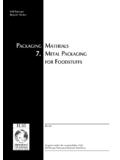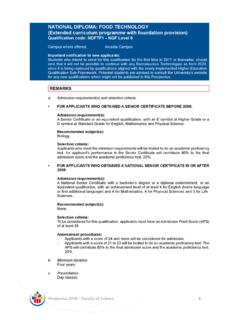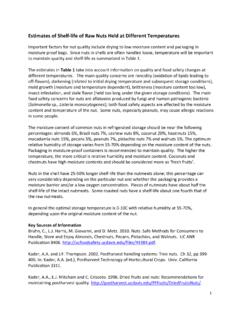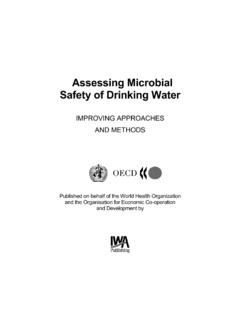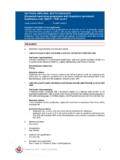Transcription of RECOMMENDATIONS FOR THE PRODUCTION OF …
1 RECOMMENDATIONS FOR THE PRODUCTION OF PREPACKAGED CHILLED FOOD ECFF RECOMMENDATIONS December 2006 Page 2 ECFF seeks to ensure that information and guidance it provides are correct but accepts no liability in respect thereof. Such information and guidance are not substitutes for specific legal or other professional advice. TABLE of CONTENTS PART 1: PRODUCT AND PROCESS DESIGN OF CHILLED FOOD Section Main hazards 8 Section Control measures 11 Section Shelf life 18 PART 2 CLASSIFICATION OF HYGIENE AREAS Section General hygiene requirements 22 Section Table defining hygiene area requirements 24 PART 3 ADDITIONAL OBLIGATIONS Section Raw materials and supplier control 43 Section HACCP 45 Section Monitoring.
2 Verification and documentation 54 Section Traceability 61 Section Recall 63 APPENDICES Appendix A Definitions and abbreviations 68 Appendix B Case studies using decision tree route to determine minimum status required 74 Appendix C Air quality 85 Appendix D Selected reading and other relevant guidelines / codes of practice 88 Appendix E ECFF aims and membership 91 ECFF RECOMMENDATIONS December 2006 Page 3 ECFF seeks to ensure that information and guidance it provides are correct but accepts no liability in respect thereof. Such information and guidance are not substitutes for specific legal or other professional advice. INTRODUCTION Chilled foods include a vast range of food products, such as ready-to-eat salads and sandwiches, ready-to-heat meals, pastas and sauces, pizza, desserts, soups, sauces, dressings and doughs.
3 These foods may include both raw and heat-processed ingredients. Further heat processing may or may not be used during the manufacturing process and by the consumer. For these reasons, chilled foods depend on refrigeration as the primary means of preservation. It is recommended that chilled food manufacturers aim to achieve <5 C in storage and distribution facilities controlled by them. It must however be recognised in the establishment of shelf life that the wider distribution chain, including retail display and consumer refrigerators may operate at higher temperatures. Legislative requirements must also be complied with.
4 A key criterion for chilled foods is that they must be microbiologically safe at the point of consumption. Pathogens that could result in food-borne illness when consumed must be controlled. Within this context, ensuring the safety and quality of chilled foods is dependent on the integrity of the entire food chain, from PRODUCTION and harvesting of ingredients, through manufacturing and distribution and finally, storage and preparation by the consumer. Because of the diversity of raw materials, processing conditions and packaging systems that are used in the PRODUCTION of chilled foods, it is not possible to establish a "one size fits all" approach to achieving microbiological safety.
5 Rather, the manufacturer must carefully consider a wide variety of factors and hurdles raw material quality, hygienic processing, temperature, water activity, acidity, modified atmosphere in determining ways to control microbiological growth and thus prevent spoilage and/or the development of conditions that can lead to food-borne illness. Via the choice and combination of these elements, the manufacturer is able to determine the optimum shelf life for a product and establish conditions for its use that will ensure safe food products for consumers. The ECFF RECOMMENDATIONS are complementary to European Union (EU) food hygiene legislation, as well as the Codex Alimentarius Code of Hygienic Practice for Refrigerated Packaged Foods with Extended Shelf Life (CAC/RCP 46-(1999)) and the Codex Recommended International Code of Practice General Principles of Food Hygiene (CAC/RCP 1-1969, Rev.)
6 3 (1997), Amd. (1999). The European Chilled Food Federation (ECFF) RECOMMENDATIONS for the Hygienic Manufacture of Chilled Foods 2005 (formerly ECFF Guidelines 1996) provide a reference for the PRODUCTION of a wide spectrum of chilled foods, outlining the fundamental principles that should be considered when designing safe manufacturing operations. The ECFF RECOMMENDATIONS provide a resource when developing national guidelines or when working with local enforcement authorities to implement legal requirements at the PRODUCTION stage. In addition, the ECFF RECOMMENDATIONS can provide guidance for the producers of chilled foods.
7 It always remains the responsibility of the Food Business Operator (FBO) to assure the safety of its products (General food law regulation (EC) No 178/2002 art. 17). It must be recognised that the task of setting up and managing a chilled food operation demands a high level of expertise to ensure that a facility is properly designed and that appropriate procedures are in place to achieve the PRODUCTION of safe foods. These procedures involve application of Good Manufacturing Practices (GMP), Good Hygiene Practices (GHP) and implementation of a Hazard Analysis and Critical Control Points (HACCP)-based system.
8 ECFF RECOMMENDATIONS December 2006 Page 4 ECFF seeks to ensure that information and guidance it provides are correct but accepts no liability in respect thereof. Such information and guidance are not substitutes for specific legal or other professional advice. SCOPE The ECFF RECOMMENDATIONS provide guidance on process design and hygienic principles related to the manufacture of chilled prepared foods (hereafter referred to as chilled foods), with emphasis on those procedures designed to control the risks associated with bacteria that cause food-borne diseases. However, as guidance, they cannot cover all of the factors that may be applicable to a specific operation.
9 It is essential that a HACCP-based system is used to identify the specific control requirements for an individual operation. The ECFF RECOMMENDATIONS relate to chilled foods that are capable of supporting the growth of pathogenic organisms. On-site catering operations must meet the general hygiene requirements (see Section ). The following foods are considered to be outside the scope of the RECOMMENDATIONS : cook-chill foods prepared by caterers; foods offered for sale at frozen or ambient temperatures; fermented foods; dairy products; foods with pH < or aw< ECFF RECOMMENDATIONS December 2006 Page 5 ECFF seeks to ensure that information and guidance it provides are correct but accepts no liability in respect thereof.
10 Such information and guidance are not substitutes for specific legal or other professional advice. MANAGEMENT RESPONSIBILITIES FBOs are legally responsible under EU General Principles of Food Law (178/2002/EC) for the safety of food products under their control. Additional national legal obligations may apply. New products must have been designed to ensure safety before being presented to customers. FBOs must understand the principles of HACCP (see section ) and GMP and ensure that they are applied; understand hazards and risks and ensure that they are managed; ensure that all personnel understand the importance of maintaining the appropriate hygienic conditions throughout the facility, including appropriate personal hygiene and cleanliness; ensure that regular, thorough and planned staff training takes place to reinforce this understanding.
